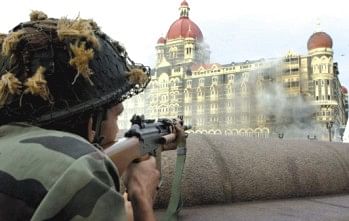|
Perceptions
TERRORISM 2.0
New media is playing a big role in terrorist causes
Karina Zannat
 |
| Photo: Zahedul i khan |
Terrorists, insurgents, and extremist ideologues have climbed new heights of psychological warfare with new media. Global access to the internet and the ease of creating and sharing videos, images, texts, and communiqués have allowed terrorists and extremist ideological thinkers to spread their message to target populations in unprecedented ways on an international scale. A unanimous agreement on the definition of terrorism has yet to emerge, but terrorism is used to refer the acts of individuals who deliberately seek to inflict damage on civilians to get a social or political message across. In contrast, an insurgency is a movement that is an organised political effort with a specific aim that may or may not use terrorism. The new media trend is not about justification, or lack thereof, of terrorist causes or the historical socio-economic factors that led to the confrontation between the two sides. Regardless of the amount of attacks planned or successfully executed, there is a global pattern amongst extremist groups to communicate with the target populations through digital means.
Others contribute to terrorist causes without providing financing or their own lives by providing theoretical frameworks and ideological rhetoric to justify the actions and political objectives of terrorists. While a terrorist attack is publicised in the newspapers for several weeks, a new media piece serving as a call to arms or evoking sympathy for a cause can be circulated between hundreds with little regard to physical distance, national borders, cultures or the financial situation of the consumers. It is important to remember that targets of terrorists are not always government officials and adversary military forces. Terrorists concentrate more on extracting revenge for social or political grievances, obtaining renown amongst civilian populations to attract new recruits and win support, and elicit a reaction from their enemy. Modern day terrorists have realised that new media is an essential tool to communicate amongst each other, their target civilian populations, and their enemies.
New media refers to the aggregation of traditional media such as film, images, music, spoken and written word, with the interactive power of computer and communications technology, computer-enabled consumer devices, and most importantly the Internet. With the connotation of being readily accessible, new media has a high level of interactivity with the individual consuming the material. Using new media has given increased flexibility to terrorist organisations, which no longer need to have expensive brick and mortar headquarters or printing presses to create and circulate messages. A single member with an Internet modem, laptop, and cell phone can now serve as the liaison between the organisation, the public, and future recruits. Such organisations network with similar organisations worldwide and exchange ideas. With English as the lingua franca and improvements in online translation tools and services, new media pieces are published in various languages, slowly eradicating language and cultural barriers.
 It is virtually impossible for counterterrorism forces to track down the origin of websites like these. The server can be hosted in a foreign nation, while the web designers can be spread out over several borders and remain unaware of each other's real identities. The websites can disappear with no warning and moved under newer, lesser-known addresses. Contributors often use different IP addresses and aliases, making it extremely difficult to track down the individual or even know their real gender. It is virtually impossible for counterterrorism forces to track down the origin of websites like these. The server can be hosted in a foreign nation, while the web designers can be spread out over several borders and remain unaware of each other's real identities. The websites can disappear with no warning and moved under newer, lesser-known addresses. Contributors often use different IP addresses and aliases, making it extremely difficult to track down the individual or even know their real gender.
The Internet grants a platform to individual terrorists and specific organisations. Whether or not anyone pays attention, organisations and individuals document their thought processes and justifications for actions. In February 2010 Joseph Andrew Stack flew a small plane into the side of an Internal Tax Revenue (IRS) building in Texas, USA, resulting in his own death and killing two others. Stack has no connections with organised terrorist groups, but before flying the plane he posted a lengthy explanation of his actions and his frustration with the American taxing system on his personal website. Even though the website was taken down at the request of Federal Bureau of Investigation, Stack's declaration was copied and passed around online. In 1999 high school students Eric Harris and Dylan Klebold killed 13 of their classmates in a shoot-out at their school and committed suicide afterward in Colorado. Investigations revealed that the two had extensive communication through chat rooms and exchanged their violent fantasies and rants online.
Insurgencies and terrorist organisations showcase their organisations for a global audience online. A growing number of the organisation websites amplify media exposure by producing two types of statements: programmatic texts outlining their basic aims and beliefs, and analytical statements that don't comment on operations but remind followers of basic rhetoric. The http://iaisite-eng.org/index.php website is maintained by the Islamic Army of Iraq (IAI) and published in English, Arabic, French, and Spanish. Copying professional legitimate organisational websites, the mission statement, history and objectives are listed under a tab labelled “About Us”. Such organisational sites are increasingly sophisticated. An example would be the creation of an easily downloadable encyclopaedia focusing on the biography, collection of statements, and ideological essays of Abu Mus'ab al-Zarqawi, a Jordanian insurgent. The encyclopaedia comes with a table of contents, complete graphic interfaces, and is padded with Osama bin Laden's statements about aggressive responses to foreign powers. The purposes and functions of extremist websites are multifaceted and can be as complex or simple as the designer wants.
 The Aum Shinrikyo organisation of Japan is responsible for carrying out the deadly Sarin gas attack in the Tokyo subway system in 1995. Since then, the organisation has changed its name to Aleph and maintains a formal website, which is heavily monitored for terrorist statements by the Japanese government. The organisation claims new leadership and a break from violent ideology, but Aleph continues to preach the teachings of the original leader Shoko Asahara, who was proven guilty for his part in the 1995 attacks. The website recruits new members and has instructions for contributing donations. The Aum Shinrikyo organisation of Japan is responsible for carrying out the deadly Sarin gas attack in the Tokyo subway system in 1995. Since then, the organisation has changed its name to Aleph and maintains a formal website, which is heavily monitored for terrorist statements by the Japanese government. The organisation claims new leadership and a break from violent ideology, but Aleph continues to preach the teachings of the original leader Shoko Asahara, who was proven guilty for his part in the 1995 attacks. The website recruits new members and has instructions for contributing donations.
The Basque Fatherland and Liberty (ETA) organisation of Spain, Kurdistan Workers Party (PKK) of Turkey, Liberation Tigers of Tamil Eelam (LTTE) of Sri Lanka, Kach and Kahane Chai of Israel, and New People's Army (NPA) of the Philippines are all terrorist and insurgent groups that do not maintain online websites but carry out sporadic small-scale attacks. Counterterrorist experts allege that these groups are often funded by online transactions of money through services like PayPal. Active members organise meetings and projects through mediums such as text messages, emails, and chat rooms. Personal email accounts, cell phone SIM cards, and online exchanges can be quickly deleted, reducing the risk of a trail of physical evidence for members in case of capture or detection.
The number of extremist websites is reported to have grown from a few dozen in the late 1990's to more than 5,000 today. Websites and forums of this nature can be monitored and eventually shut down, but developing linguistic and personnel skills to keep track of the vast traffic online is nearly impossible and government initiatives to do so will probably result in failure. Even if monitoring agencies are successful, extremist messages can be disguised in code or hidden through multiple accounts. The answer doesn't lie in banning sites and increasing government control over Internet use. After all, restricting free speech and personal rights would be counterproductive if a government wants to show terrorist organisations that their activities do not impact civil societies. Instead, the root economic, social, and political sources of terrorist ideology need to be re-examined and feasible solutions must be implemented.
That being said, it is an organisation error for counterterrorism forces of Bangladesh to be unaware of extremist activity on the Internet. The older generation of Bangladesh is still stuck in a digital rut where emails are a novelty, while the younger generation is well-trained in Google searches and have daily access to the internet. Bangladesh fluctuates between a potential extremist nation and a bastion of anti-extremist secular culture depending on which counterterrorist expert is asked. If Bangladesh aims to maintain a moderate image in the international arena, numerous factors need to be considered. Economic liberalisation and growth resulting in lesser unemployment, changes in cultural norms that decrease social marginalisation of citizens based on ethnicity and religion, and the integration politically marginalised factions of the population in to the political process are all important factors that will contribute to lessening the number of potential extremist thinkers and terrorists. However, counterterrorism agencies can update their understanding and knowledge of the scope of online extremist sources of information as a short-term change that can be implemented immediately. Terrorism has evolved and benefited from technology and its high time counterterrorism forces in Bangladesh do the same.
Copyright
(R) thedailystar.net 2010 |
| |
